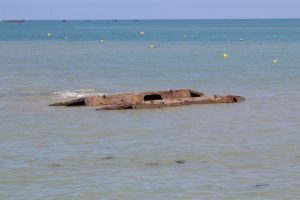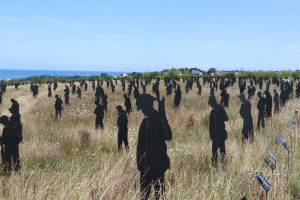
Harold Bayeux Tapestry
We are moored at Caudebec en Caen. Whilst I am sure that our river boat could navigate further along the river we will spend two nights here and our excursions to the channel coast will be by coach. Today is the longest excursion on this tour with an early start – as we shall be visiting the sight of the D Day landings near Arromanches this afternoon but first we head to Bayeux to visit the famous tapestry.
Historically the experts now agree the Bayeux Embroidery was created in Southern England at the request of Bishop Odo, brother of William the Bastard (as he was known until he became the Conqueror), to reflect the various promises that William would inherit the English crown made by Edward the Confessor. Bishop Odo was the Bishop of Bayeux.
My picture above comes from Aspects of History which argues that whilst the scene is depicted above the limited contemporary records refer to Harold being seriously mutilated and hard to identify – so just maybe that famous story is not entirely true!
We are given handheld recorders describing the embroidery scene by scene. All well and good as it indicates the supposed pace of movement – except that some in front of us seem unable to move forward at the inherent pace so I am constantly trying to look a couple of scenes ahead to see what is being described; it is not possible to pause the recording as it is a crowd control issue. The Tapestry (it is actually technically an embroidery) will be coming to the British Museum in 2027 so I wonder what visitor numbers it will attract.
We also have a few spare minutes to see the exterior of Bayeux Cathedral.
At Arromanches we visit the D Day landing museum. One aspect new to me is that Mulberry Harbour A (American) was destroyed in the bad weather which came soon after D Day and only the B (British) Harbour could be used to bring in everything until November 1944. The advancing forces took Antwerp in the September but there was no clear path until the conclusion of the Battle of the Scheldt to open and clear the estuary for use by Allied Troops. The logistics of the Mulberry Harbour as a single point of failure must have caused many sleepless nights for those concerned.
We then visit the D Day Arromanches British War Graves – here dominated by the large numbers of very young soldiers. We then move onto the relatively recent (June 2021) British Normandy Memorial recording the names of the 22,442 individuals under UK command who lost their lives between 6 June 1944 and 31 August 1944. It was brought into being after it was noted that other nations already had a dedicated memorial.
It has been beautifully completed. These European reminders of the horrors of the two World Wars did not stop the Argentinians in 1982 and seem to have no recognition currently in either Israel or Russia who continue their plans to grab the territory of others. Indeed there has recently been talk of the USA demanding that Canada and Greenland become part of that country.
For D Day 80 1475 silhouettes names “Standing with Giants” were placed on the hillside below the Memorial and they returned this summer representing those lost under British command on 6 June 1944. It commenced as a small community project but these images have appeared widely over the last few years.


